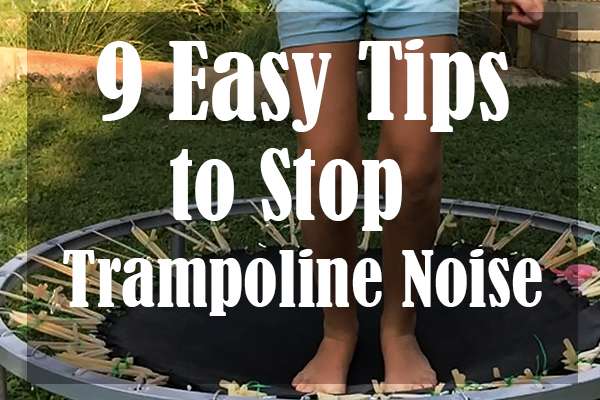
9 Easy Tips to Stop Trampoline Noise
If there’s one thing that can take a real damper on all of the fun we could be having on our trampolines, it’s trampoline noise complaints. Fortunately, there are many ways to stop trampoline noise - and we’ll tell you all about them right here. However, before we just jump in, let’s talk a bit about why trampolines tend to get squeaky after a while.
Why Is My Trampoline So Noisy and Squeaky?

As you can imagine, repeatedly jumping on anything is bound to make it produce some kind of noise. But trampolines are meant to be jumped on! So why are they so noisy?
Well, trampolines, in particular, tend to squeak after a while for one of two reasons. It’s either just a matter of the friction between the metal parts, such as the springs and the metal frame. You might also get some metal-on-metal rubbing at the joints of the frame where the screws are.
The other option is much harder to fix. If you can see a bit of rust on your trampoline, that might be fixable. However, if the frame has rusted through, it's not safe for jumping anymore. You should get a new one, and not only to avoid trampoline noise complaints.
Some trampolines will continue to squeak even after you eliminate the friction and the rust. If that happens, you could be looking at a mat problem. But that's typically easy to fix.
Trampoline Spring Noise

Allow us to explain why trampoline springs are usually the biggest trampoline noise nuisance. But really, how can they not be noisy? While the springs are the perfect design to give us just the right amount of bounce when we’re jumping around, no one ever said they were the quietest of designs.
You see, the spring itself is a very tight coil, so it actually makes some noise every time it snaps together. The resulting sound is something we love about trampolines. If you hear that sound, it means that you’re already in the air. Still, if someone is particularly sensitive to any type of sound, trampoline noise complaints are inevitable.
However, we should all do what we can to focus on what we can fix. In this case, that means that we’re focusing on keeping the spring itself clean and lubricated. Additionally, we’ll also want to pay attention to the eyelet on the frame the springs hook onto. In fact, sometimes simply greasing this area will get rid of most of the noise.
Do Mini Trampolines Make Noise?
Just like bigger yard trampolines, mini trampolines — rebounders — can start squeaking after a while. The causes are usually the same if the trampoline has springs.
However, some mini trampolines have managed to get around the noise issue. While many of them still use metal springs to attach the mat to the frame, some also have bungee cord connections. So the mat is held to the frame by durable and stretchy fabric which should be less noisy than metal springs.
Still, the real problem you might run into with smaller trampolines is just the fact that we use them in our homes. Despite the fact that most of them have rubber caps covering the feet to keep them from sliding or making an impact on the floor, they’re still going to be a little noisy. If you want to avoid getting trampoline noise complaints from your downstairs neighbors, simply keep the tramp on a carpet.
How to Stop the Noise
Finally, we can share some tips for keeping your trampoline quiet. Safety first, though: protect your hands when you’re working around sharp metal parts. Trampoline springs can be really tricky, so if you’re not used to handling them, practice caution! Now, what’s the first thing we should try to silence our trampolines?
1. Clean the Trampoline Mat
Sometimes, the squeaking noise will be coming from the mat itself. As long as you regularly perform trampoline maintenance and clear away the excess dirt, you should be fine. Just don’t leave the trampoline wet, as that could cause additional noise. Not to mention how dangerous it is to jump on a damp mat.
2. Spray on Rust Remover
If you notice any rust that’s just popping up on your springs or the frame, you may be able to get it off with a rust remover. Just spray the liquid on wherever you need it and let it sit. Depending on the instructions written on the product you’ve purchased, you could be waiting for anywhere between 15 minutes to a few hours. When the solution has done its thing, use a small nylon brush to scrub away the rust.
3. Clean the Trampoline Frame
You probably shouldn’t leave the rust remover on the trampoline frame. So once you’re done scrubbing, wash the frame and the springs with some water. Make sure to pick up the excess water with clean rags. Or, you can just leave the trampoline out in the sun to dry.
4. Use WD-40 on the Springs

WD-40 is pretty much a miracle product when it comes to working with moving metal parts. Not only is it an effective lubricant, but it acts as a corrosion inhibitor as well. Ask a friend or your child to jump on the trampoline while you go around spraying the frame joints and the springs.
5. Grease the Joints
We’d be surprised if your trampoline is still squeaking after all of that. However, if you still hear the noise, just hit the trampoline with some grease or even Vaseline. Take the tip of your finger and get about a pea-size amount out of the pot. Then, you’ll want to stuff it into the top side of the eyelet where the spring hooks onto the frame. Keep in mind that it’ll take a few minutes of your jumping on the trampoline for the product to coat everything.
Best Long-Lasting Lubricant to Stop Trampoline Noise
- Lubricates up to 10 Times Longer Than Conventional Lubricants
- Repels Moisture, Dust and Dirt
- Functions as Lubricant and Protective Coating
- Transparent, Non-staining and Odorless
- Dries to solid film with no sticky residue
6. Replace Damaged Springs
As a trampoline owner, you should also know how to determine whether you need to replace your springs. If the rust has advanced, it’s time to get new springs. Measure the length of the ones you have and count them. Then head on over to either your local hardware store or an online retailer. Really, springs are pretty easy to find.
7. Deal with the Screws
Of course, the other metal parts on our trampolines are the screws. There are several reasons why they might cause a trampoline noise nuisance. For one, they could have come loose, which would cause the whole trampoline to rattle as you bounced. Additionally, the screws might also be rusty — in which case you should unscrew them and clean them up. Then hit them with a bit of WD-40 and put them back in. Or buy new ones.
8. Replace the Screws with Bolts
On the other hand, if you want a connection that absolutely won’t budge — and therefore won’t cause the creaking noise of metal shifting against metal — you can also get bolts instead of screws. These fasteners won’t come out at all, so there’s no chance for the trampoline to rattle.
9. Store the Trampoline Properly

You can also take steps to avoid getting trampoline noise complaints altogether. Other than the standard maintenance you should perform periodically, you can also keep the tramp in the upright position. This should lessen the pressure on the joints. With a bit of grease, you’ll be able to keep the trampoline in working condition for years to come.
On Avoiding Trampoline Noise Complaints
If your neighbors have been complaining about trampoline noise nuisance, you should now have one less thing to worry about. But now we want to hear from you: do you have any special tips for cleaning and greasing your trampoline? Share your advice down below and share this post with any friends who might need to see it!


